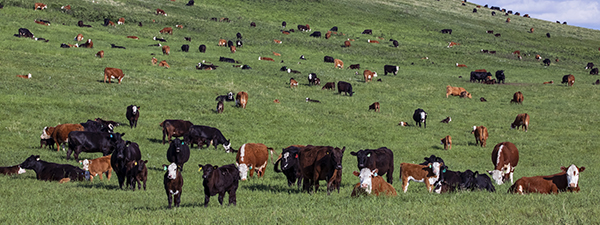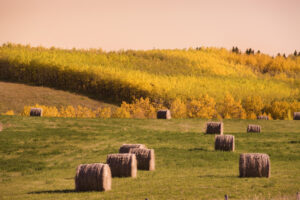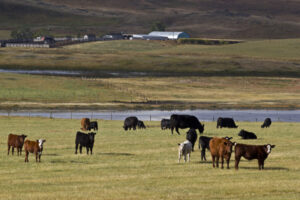Taking Inventory of Feed Resources – How to Right-Size Your Cow Herd
Editor’s note: The following is part one of a two-part series. Stay tuned for the next instalment with a focus on how producers worked to right-size their herds — and cows — on their farms.

While feed costs have come down some this summer, hay prices remain at historically high levels and have been trending higher in many regions over the last ten years. Current market signals are encouraging producers to “right-size” their cow herd to minimize winter feed and rely on grazing as much as possible. But this is not a “one size fits all” conversation. In fact, there are a couple of ways that producers can accomplish matching their herd to their feed resources.
What is the right number of cows for your farm?
There are several reasons an operation may choose to scale back its herd size. Drought recovery may require fewer animals to avoid overgrazing. Abundant rain may have increased forage production to support a larger herd at one time, however the increased grazing capacity may no longer be present now or in the foreseeable future. Winter feed challenges, either with feed availability or capacity to harvest it, can result in a change in production system. Or adjusting may be due to the desire to reduce labour required for harvesting forage and winter feeding.
- calving date
- weaning date
- winter feed ration
- winter feeding days
- housing

The first thing to do is a thorough assessment of forage resources. The ability of a pasture or hayland to produce forage is measured in Animal Unit Months (AUMs). The ranch’s ability to produce forage may stay relatively constant, but how that forage is used can vary significantly. For example, using information from the Canadian Cow-Calf Cost of Production Network (COP Network), for most western Canadian cow-calf operations, if the cow herd was decreased by 10%, grazing days could be increased by 10%. (Notable exceptions occurred in the east as this relationship did not hold).
The impact of increasing grazing days and reducing winter feed days will vary by production system but can have a proportionately larger impact on operations with high feed costs per head per day. Examples of such farms might be those that rely on purchased feed to supplement homegrown production or that have high cost structures (for example, machinery or unpaid labour) that contribute to the cost of homegrown feed or sourcing feed. If feed supplies are going to be tight this winter, producers may be taking a hard look at what cows could be culled to stretch feed resources.
When considering the right number of cows for an operation, there are trade-offs with economies of scale that producers face. When winter feed is relatively cheap, the incentive can be to expand the herd. In this case, more cows mean less overall available grazing days for the herd (assuming land base and carrying capacity remain steady) and result in more days that the herd is being fed. This does reduce overhead costs per cow by spreading total costs over more animals. In contrast, a smaller herd results in overhead costs being spread over fewer animals, increasing costs per cow or per pound of calf weaned. Producers must carefully evaluate the trade-offs between lower winter feed costs and the impact on the operation through reduced economies of scale.
What is the right size of cow for your farm?

Another way of looking at this question is not about the number of cows that overhead costs can be spread over, but rather the mature cow weight.
The COP Network found that the top third most profitable farms had mature cow weights that were 30 pounds lighter than the medium third group and 45 pounds lighter than the lowest third. Culling not just the oldest cows, but the heaviest cows, has the potential to support future profitability on the operation. Heavier cows eat more per day than a lighter-weight cow, and therefore by reducing mature cow weight, forage resources can be saved not by reducing winter feeding days but by how much feed is consumed per day.
Selecting smaller framed cows is usually a longer process, as it takes time to change the entire herd. One of the considerations is how this will impact weaning weights and overall revenue.
The COP Network found that those top third most profitable farms had weaning weights that were actually four pounds heavier than the medium third group and 17 pounds lighter than farmers in the lowest third of profitability. So, while the mature cow weight was different enough to make an impact on winter feed requirements, the difference in weaning weight was not as directly impacted. Year-to-year fluctuations in weaning weight were likely impacted more by genetics, pasture conditions and forage availability than cow size. This selection of smaller, more efficient cows that require less feed or forage per day can have a big impact over the long-term.
Producers should assess their long-term forage and feed resources, as well as take a hard look at their existing herd, considering how cow size factors into cost management, feed use and weaning weights. This information can be invaluable when deciding what size of herd — or cow — makes the most sense for them.
lEARN mORE
- Winter Feed Cost Comparison Calculator (BCRC interactive calculator)
- Record-Keeping & Benchmarking (BCRC resources)
- Grazing Management (BCRC webpage)
- Drought Management Strategies (BCRC webpage)
Sharing or reprinting BCRC posts is welcome and encouraged. Please credit the Beef Cattle Research Council, provide the website address, www.BeefResearch.ca, and let us know you have chosen to share the article by emailing us at [email protected].
Your questions, comments and suggestions are welcome. Contact us directly or spark a public discussion by posting your thoughts below.